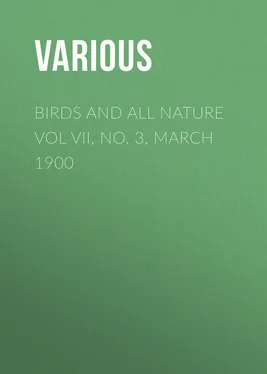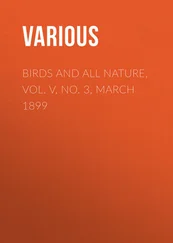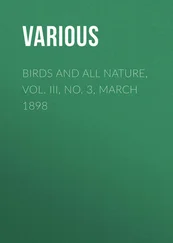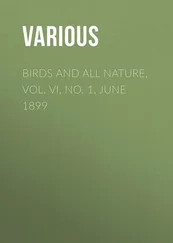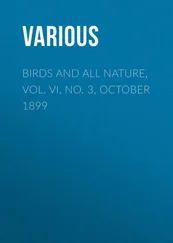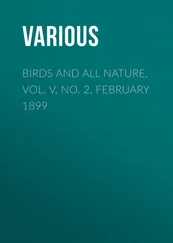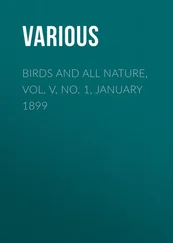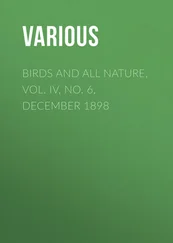Various - Birds and all Nature Vol VII, No. 3, March 1900
Здесь есть возможность читать онлайн «Various - Birds and all Nature Vol VII, No. 3, March 1900» — ознакомительный отрывок электронной книги совершенно бесплатно, а после прочтения отрывка купить полную версию. В некоторых случаях можно слушать аудио, скачать через торрент в формате fb2 и присутствует краткое содержание. Жанр: periodic, Биология, Природа и животные, foreign_edu, на английском языке. Описание произведения, (предисловие) а так же отзывы посетителей доступны на портале библиотеки ЛибКат.
- Название:Birds and all Nature Vol VII, No. 3, March 1900
- Автор:
- Жанр:
- Год:неизвестен
- ISBN:нет данных
- Рейтинг книги:4 / 5. Голосов: 1
-
Избранное:Добавить в избранное
- Отзывы:
-
Ваша оценка:
- 80
- 1
- 2
- 3
- 4
- 5
Birds and all Nature Vol VII, No. 3, March 1900: краткое содержание, описание и аннотация
Предлагаем к чтению аннотацию, описание, краткое содержание или предисловие (зависит от того, что написал сам автор книги «Birds and all Nature Vol VII, No. 3, March 1900»). Если вы не нашли необходимую информацию о книге — напишите в комментариях, мы постараемся отыскать её.
Birds and all Nature Vol VII, No. 3, March 1900 — читать онлайн ознакомительный отрывок
Ниже представлен текст книги, разбитый по страницам. Система сохранения места последней прочитанной страницы, позволяет с удобством читать онлайн бесплатно книгу «Birds and all Nature Vol VII, No. 3, March 1900», без необходимости каждый раз заново искать на чём Вы остановились. Поставьте закладку, и сможете в любой момент перейти на страницу, на которой закончили чтение.
Интервал:
Закладка:
Various
Birds and all Nature Vol VII, No. 3, March 1900 / Illustrated by Color Photography
THE ENGLISH SPARROW
You may talk about th' nightingale, th' thrush 'r medder lark,
'R any other singin' bird that came from Noah's ark;
But of all feathered things thet fly, from turkey-buzzard down,
Give me the little sparrer, with his modest coat o' brown.
I'll admit that in th' springtime, when th' trees 're gettin' green,
When again th' robin red-breast 'nd th' bluebird first 're seen;
When the bobolink 'nd blackbird from th' southland reappear,
'Nd the crow comes back t' show us that th' spring is really here —
I'll admit that in the springtime , when the groves with music ring,
Natur' handicaps th' sparrer; he was never taught to sing;
But he sounds th' Maker's praises in his meek 'nd lowly way;
'Nd tho' other birds come back at times, he never goes away.
There's a cert'in sort o' people thet, when th' skies 're bright,
Will hang around 'nd talk about their friendship day 'nd night;
But if things cloudy up a bit 'nd fortune seems t' frown,
They're sure t' be th' first t' kick a feller when he's down.
So when the summer skies 're bright it's easy 'nough t' sing;
But when it's cold 'nd rains 'r snows it's quite a diff'rent thing.
In autumn, when th' nippin' frosts drive other birds away,
Th' sparrer is th' only one with nerve enough t' stay.
'Nd even in midwinter, when th' trees 're brown 'nd bare,
'Nd th' frosty flakes 're fallin' thro' th' bitter bitin' air,
Th' sparrer still is with us – t' cheer us when we're glum,
Fer his presence is a prophecy of better days t' come.
Th' sparrer's never idle, fer he has t' work his way;
You'll always find him hustlin' long before th' break o' day.
He's plucky, patient, cheerful, 'nd he seems t' say t' man,
"I know I'm very little, but I do th' best I can."
What more can you 'nd I do than t' always do our best?
Are we any more deservin' than th' "little British pest?"
So, when you talk of "feathered kings" you'd better save a crown
Fer the honest little sparrer, with his modest coat o' brown.
THE PEACOCK
With pendant train and rustling wings,
Aloft the gorgeous peacock springs;
And he, the bird of hundred dyes,
Whose plumes the dames of Ava prize.
IT WAS a saying among the ancients, "As beautiful as is the peacock among birds, so is the tiger among quadrupeds." The birds are of many varieties, some white, others with crests; that of Thibet being considered the most beautiful of the feathered creation. The first specimens were brought to Europe from the East Indies, and they are still found in flocks in a wild state in the islands of Java and Ceylon. The common people of Italy describe it as having the plumage of an angel, the voice of a devil and the intestines of a thief. In the days of king Solomon his navies imported from the East apes and peacocks, and Ælian relates they were brought into Greece from some barbarous country, and that a male and a female were valued at a hundred and fifty dollars of our money. It is said also that when Alexander was in India he saw them flying wild on the banks of the river Hyarotis, and was so struck with their beauty that he imposed a fine on all who should slay or disturb them. The Greeks were so much taken with the beauty of this bird, when first brought among them, that it was shown for money, and many came to Athens from surrounding countries to see it. It was esteemed a delicacy at the tables of the rich and great and the birds were fatted for the feasts of the luxurious. Hortensius, the orator, was the first to serve them at an entertainment at Rome, and they were spoken of as the first of viands. Barley is its favorite food, but as it is a proud and fickle bird there is scarce any food it will at all times like. It lays waste the labors of the gardener, roots up the choicest seeds, and nips favorite flowers in the bud. He requires five females to attend him, often more. The peahen is compelled to hide her nest from him that he may not disturb her sitting. She seldom lays above a dozen eggs, which are generally hatched about the beginning of November. Though the peafowls invariably roost in trees, yet they make their nests on the ground, and ordinarily on a bank raised above the common level. The nest consists of leaves and small sticks. From January to the end of March, when the corn is standing, the flesh is juicy and tender, but during the dry season, when the birds feed on the seeds of weeds and insects, it becomes dry and muscular.
In some parts of India peacocks are extremely common, flocking together in bands of thirty and forty in number, covering the trees with their splendid plumage and filling the air with their dissonant voices. Captain Williamson mentions that he saw at least twelve or fifteen hundred from where he stood.
Peacocks are very jealous of all quadrupeds, especially of dogs. When they are discovered in a tree situated on a plain, if a dog is loose and hunts near it, the birds will rarely move but will show extreme uneasiness. One of these birds in the north of Ireland was a curious mixture of cruelty and fun. He had four mates but he killed them all successively by pecking them to death, for what cause no one could ascertain. Even his own offspring shared the same fate, until his owner placed the peafowl's eggs under a sitting hen and forced her to hatch the eggs and care for the young. His great amusement was to frighten the chickens. There were two iron troughs in which the food for the chickens was placed daily. No sooner had they gathered about them, when the peacock would erect his train, rattle his quills together with that peculiar rustling sound that is so characteristic of these birds, and march slowly toward them. The poor little chicks would slowly back away from the troughs as the peacock advanced, not wishing to lose sight of the food yet not daring to remain in defiance of their persecutor. By degrees he got them all into a corner, crouching together and trembling when he would overshadow them with his train, place the ends of the feathers against the wall so as to cover them, rattle his quills, in order to frighten them, and then strut off proud of the trick he had played. He did not care for the food which he left untouched.
The peacock's disposition is as variable as that of many other creatures, some being mild and good-tempered, while others are morose and jealous in the extreme. His train, though popularly called his tail, is in reality composed of the upper tail coverts, which are enormously lengthened and finished at their extremities with broad, rounded webs, or with spear-shaped ends. The tail feathers are of a grayish brown color seven or eight inches in length, and can only be seen when the train is erected, that being its appointed task. The female is much smaller than her mate and not nearly so handsome, the train being almost wanting, and the color ashy brown, with the exception of the throat and neck, which are green.
The peacock lives about twenty years and the beautiful variegated plumage of the male's train appears about the third year after birth.
THE SONG OF THE LARK
The peasant girl, her feet all bare,
With her rustic grace, has a noble air.
She's queen of the stubble-field and she,
In mind, is free as the lark is free.
Интервал:
Закладка:
Похожие книги на «Birds and all Nature Vol VII, No. 3, March 1900»
Представляем Вашему вниманию похожие книги на «Birds and all Nature Vol VII, No. 3, March 1900» списком для выбора. Мы отобрали схожую по названию и смыслу литературу в надежде предоставить читателям больше вариантов отыскать новые, интересные, ещё непрочитанные произведения.
Обсуждение, отзывы о книге «Birds and all Nature Vol VII, No. 3, March 1900» и просто собственные мнения читателей. Оставьте ваши комментарии, напишите, что Вы думаете о произведении, его смысле или главных героях. Укажите что конкретно понравилось, а что нет, и почему Вы так считаете.
